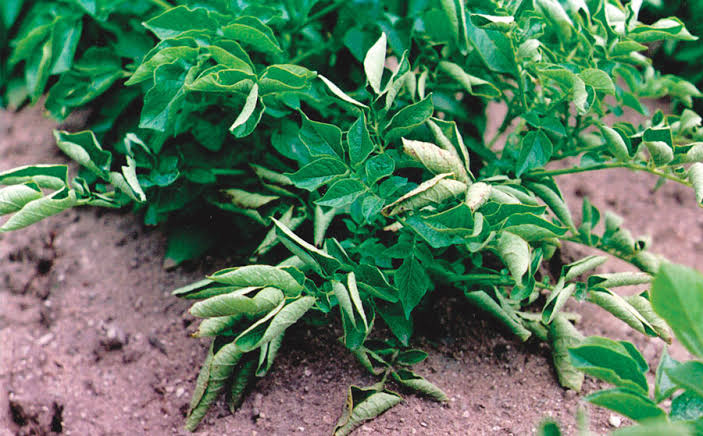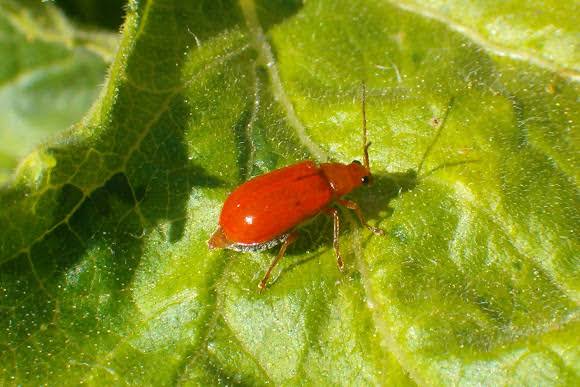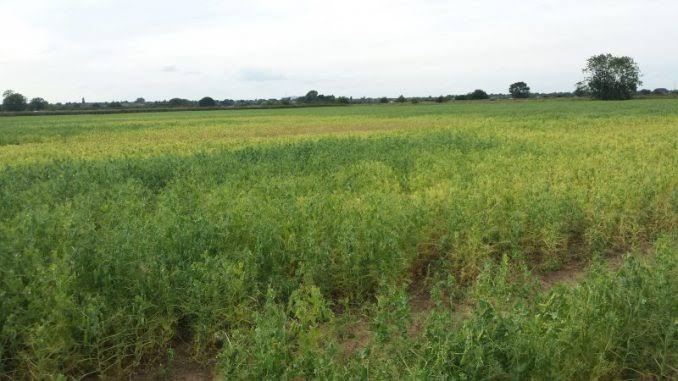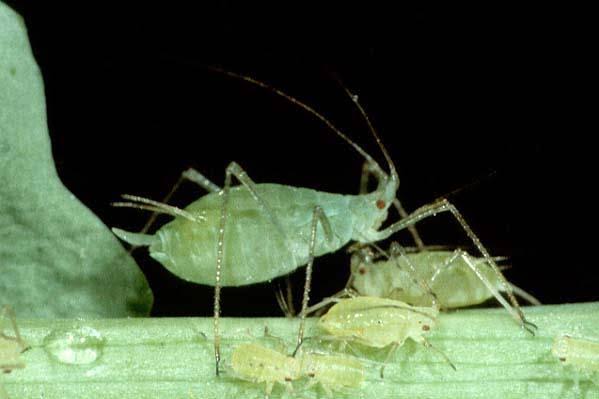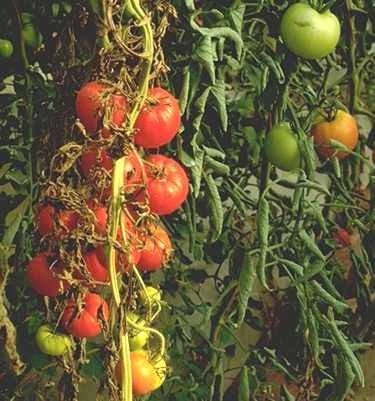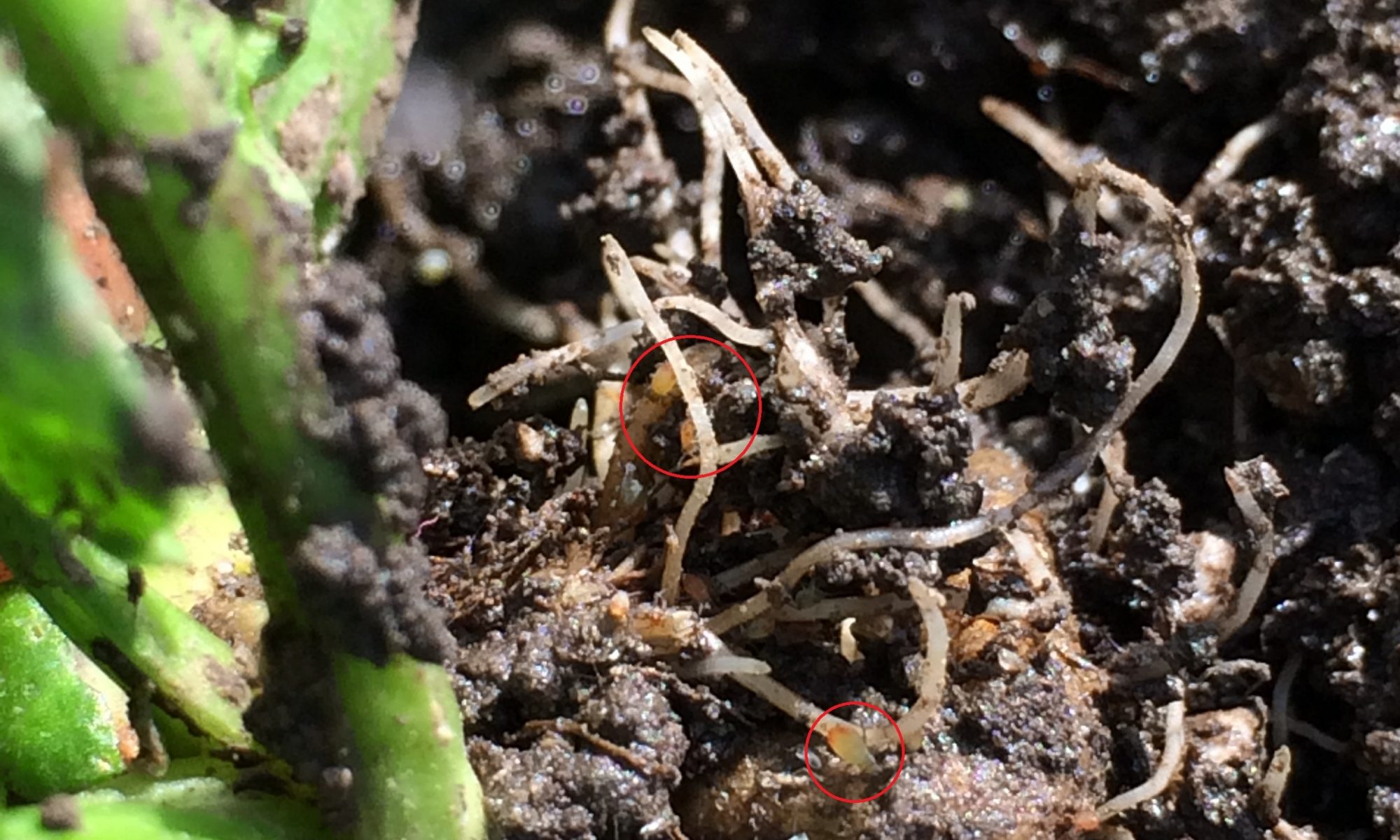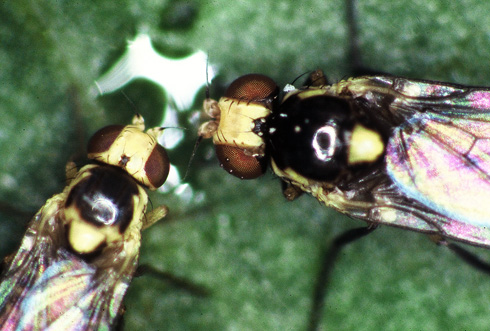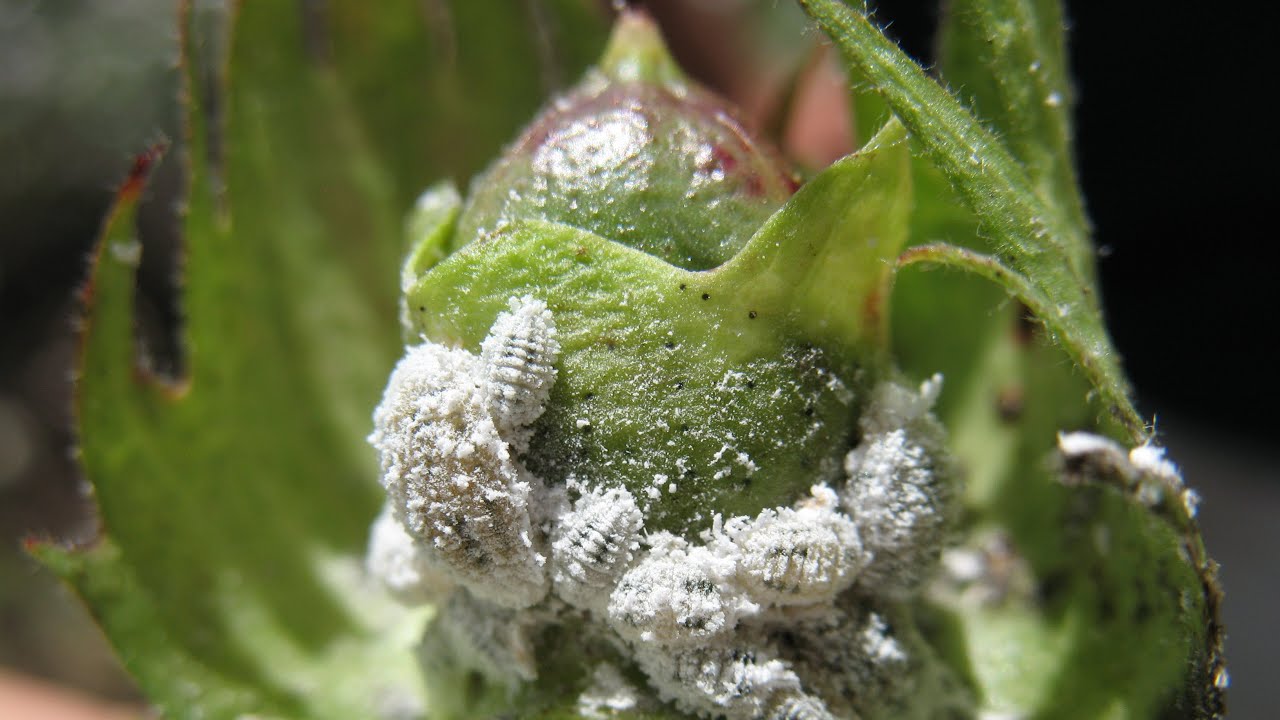- The new leaves are also greatly reduced in size and wrinkled, are yellow between the veins
- The disease is managed by using virus-free seed potatoes.
- Multiplying virus-free seed in aphid free areas.
- The population of aphid vectors is controlled by the application of suitable contact/systemic insecticides.
- For effictive control of aphid, Spray Acetamiprid 20% SP @ 10 Gm/ 15 Litre water or Imidacloprid 17.8% SL @ 10 Ml/15 Litre water.
Control of Red Pumpkin Beetle in Bitter Gourd
- As insect pupates in the soil, deep plowing soon after the crop exposes and kill grubs and pupae.
- Apply Cartap hydrochloride 3 G granule + 2 kg beauveria bassiana 3-4cm deep in the soil near the base of germinated seedlings.
- Spray the crop with2 kg beauveria bassiana + Cypermathrin 4 % EC +Profenofos 40%EC @ 400 ML/acre.or
- Spray the crop with 2 kg beauveria bassiana + lambda Cyhalothrin 4.9%CS @ 200ml/acre.
Control of bulb splitting In Onion (physiological Disorder)
- Use uniform irrigation and fertilization practices to prevent the phase of bulb splitting.
- The use of slow growth of the onion bulb varieties can reduce the incidence of this disorder.
Control of Blight and Foot Rot in Pea Crop
- Use healthy seeds and treat them with Carbendazim+Mancozeb @ 250 Gm/ quintals seed before sowing.
- Spray infected crop with Mancozeb 75% @ 400 gm/Acre at flowering and afterwards at 10-15 days intervals . or
- Spray infected crop with Thiophanate methyl 70% Wp @ 250 gram/acre.or
- Spray infected crop with Chlorothrlonil 75% WP @ 250 gram/acre.
- Remove diseased plants and destroy them.
- Maintain proper drainage.
Control of Aphids in Pea
- Small green insects, adults are large pear-shaped green, yellow or pink in color.
Damage:-
- Suck the plant sap from leaves, flowers, and pods.
- The affected leaves often get cupped or become irregularly distorted, shoots become stunted and malformed.
- Honeydew secreted by the aphids encourages the growth of Sooty mold.
Control of Root-Knot Nematode in Tomato
- Use resistant varieties.
- Do use deep summer plowing to control root-knot nematode.
- Neem cake at the rate of 80 Kg/Acre should be applied for effective control.
- Carbofuran 3G at the rate of 8 kg/acre should be applied as a soil treatment.
- Paecilomyces lilacinus-1% WP @ 10 g / kg seed for seed treatment, 50 gm / meter sq Nursery Treatment, 2.5 to 5 kg/ Hectare Soil application.
Management of root aphid in Wheat
- Avoid late sowing.
- Avoid using excessive nitrogen fertilizers.
- If the infestation in standing crop, Spray imidacloprid 17.8% SL @ 60-70 ml/acre.
- Or apply thiamethoxam 25% WG @ 100 gm + beauveria bassiana 2 kg/acre in soil with fertilizer/Sand/soil before irrigation.
Major Diseases and Their Control Measures of Wheat
Rust is a major disease of wheat crop and there are 4 types of rust found in wheat i.e. Yellow Rust (Strip Rust), Leaf Rust (Brown Rust), Black Rust (Stem Rust).
Symptom-
- Yellow Rust (Strip Rust) :- Stripe rust is caused by the fungus Puccinia striiformis. It is easily distinguished from other wheat rusts by the orange-yellow spores, which produce small, closely packed pustules developing into stripes along the length of the leaf veins. The spores occur on the upper surface of the leaves, the leaf sheaths, awns and inside of the glumes.
-
Favorable Condition:- Stripe rust requires cool and wet conditions to infect the crop. Free moisture on the leaves and an optimal temperature (10-15°C) are required for infection. Pustules erupt within 10-14 days after infection. The disease can cause up to 25% yield loss.
-
Leaf Rust (Brown Rust):- Leaf rust is caused by the fungus Puccinia triticinia. The disease can also infect rye and triticale. Leaf rust produces reddish-orange colored spores that occur in small, 1.5 mm, circular to oval-shaped pustules. These are found on the top surface of the leaves, distinguishing leaf rust from stem rust which is found on both surfaces of the leaf.
- Favorable Condition:- The spores require 15 to 20º C temperature and free moisture (dew/rain/irrigation) on the leaves to successfully infect wheat. The first signs of the disease (sporulation) occur 10-14 days after infection. Removal of volunteer wheat plants, which forms a green bridge for the fungus through the summer, can eliminate or delay the onset of leaf rust.
- Black Rust (Stem Rust):– Stem rust is caused by the fungus Puccinia graminis f. sp. tritici. In addition to wheat, it can also attack barley, rye, and triticale. Stem rust produces reddish-brown spore masses in oval, elongated or spindle-shaped pustules on the stems and leaves.Unlike leaf rust, pustules erupt through both sides of the leaves. Ruptured pustules release masses of stem rust spores, which are disseminated by wind and other carriers.
- Favorable Condition:- Stem rust develops at higher temperatures than the other wheat rusts within a range of 18-30°C. Spores require free moisture (dew, rain or irrigation) and take up to six hours to infect the plant and pustules can be seen after 10-20 days of infection.
Management:-
- Destroy volunteer wheat plants.
- Crop rotation is very important in the case of the yellow spot.
- Growing resistant varieties is an economical and environmentally friendly way of disease reduction.
- During the growing season active crop monitoring is very important for an early detection of diseases.
- Avoid repeated use of fungicides with the same active ingredient.
- Spray Kasugamycin 5% + Copper Oxychloride 45% WP 320 gm/acre or Propiconazole 25% EC 240 ml/Acre.
Like and share with other farmers by clicking on button below
ShareControl of leaf miner in pea
- Spraying of systemic insecticide like
- Deltamethrin 2.8% EC @ 200 ml/acre or
- Triazophos 40% EC @ 350-500 ml/acre. Or
- Chlorpyrifos 20%EC @ 500 ml/acre or
- Cartap Hydrochloride 50 % SP @ 250 gm/ acre are recommended.
Like and share with other farmers by clicking on the button below
ShareManagement of Mealy Bug in Cotton
- Remove the alternate weeds hosts.
- Monitor the incidence regularly and look for crawler emergence.
- Take up the management at the initial stage to get maximum control.
- Wherever necessary use neem based botanical insecticides such as neem oil @ 75 ml per pump or NSKE @ 75 ml per pump.
- Use of Dimethoate @ 30 ml/pump or Profenophos @ 40 ml/pump or Buprofezin @ 50 ml/pump may be adopted as an alternative.
Like and share with other farmers by clicking on the button below.
Share
